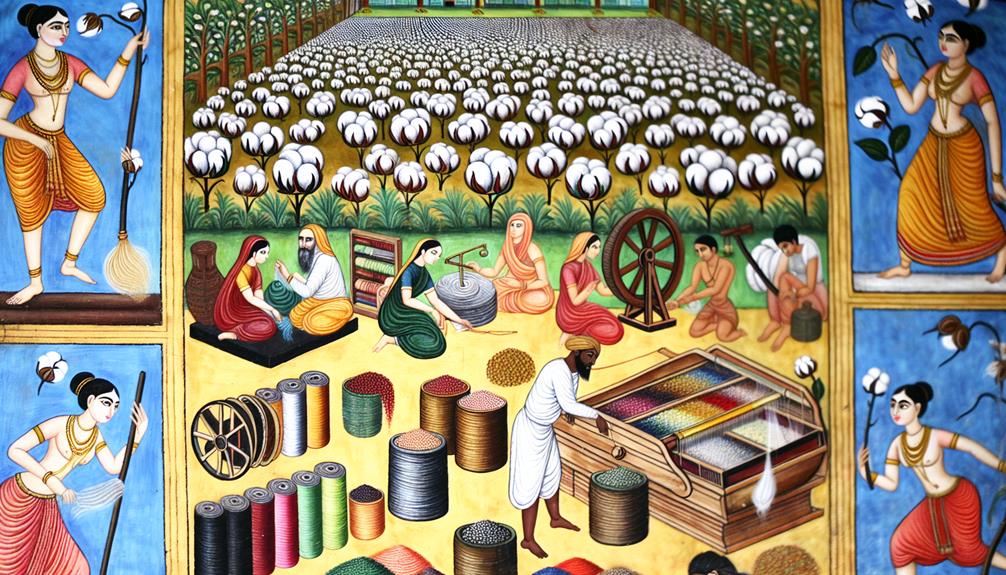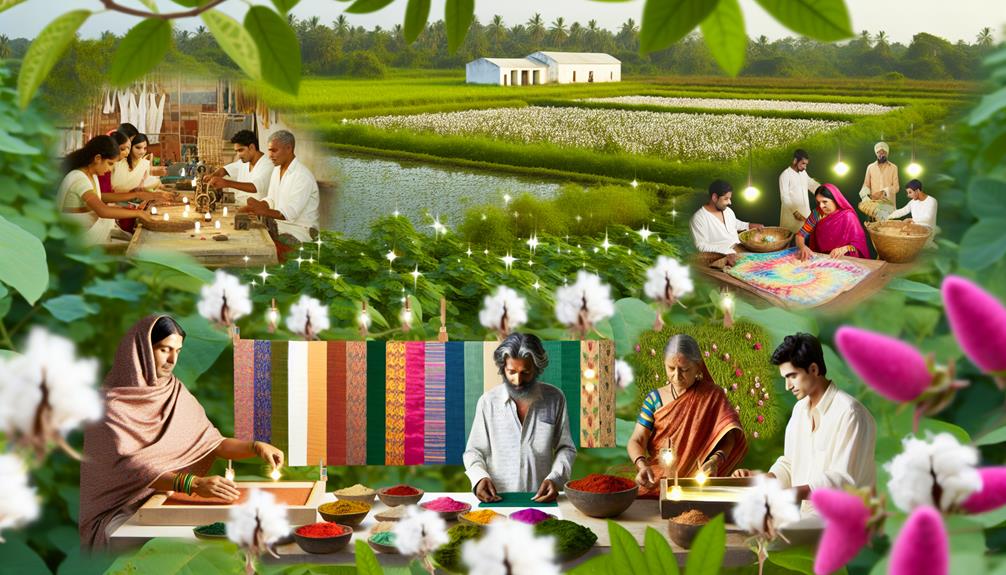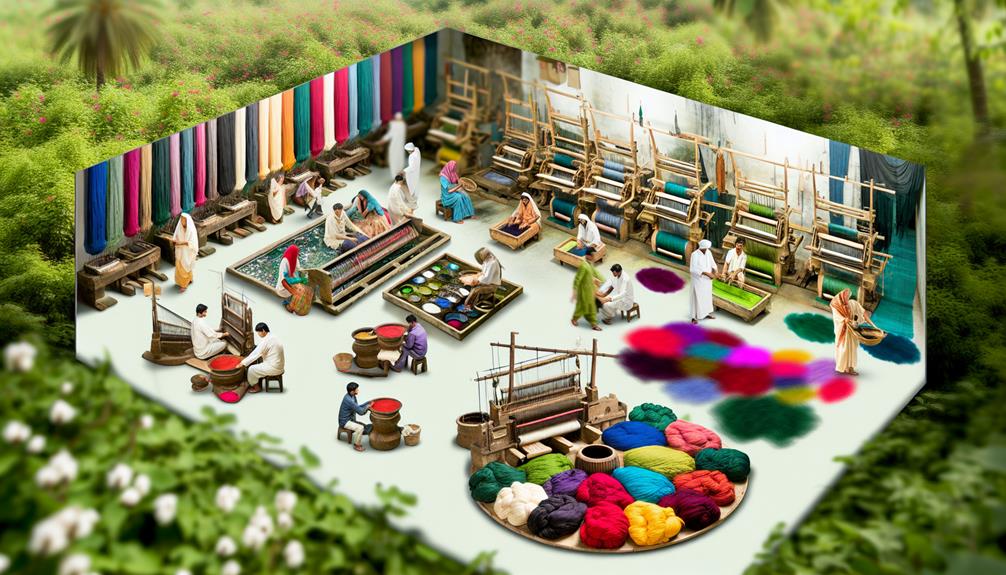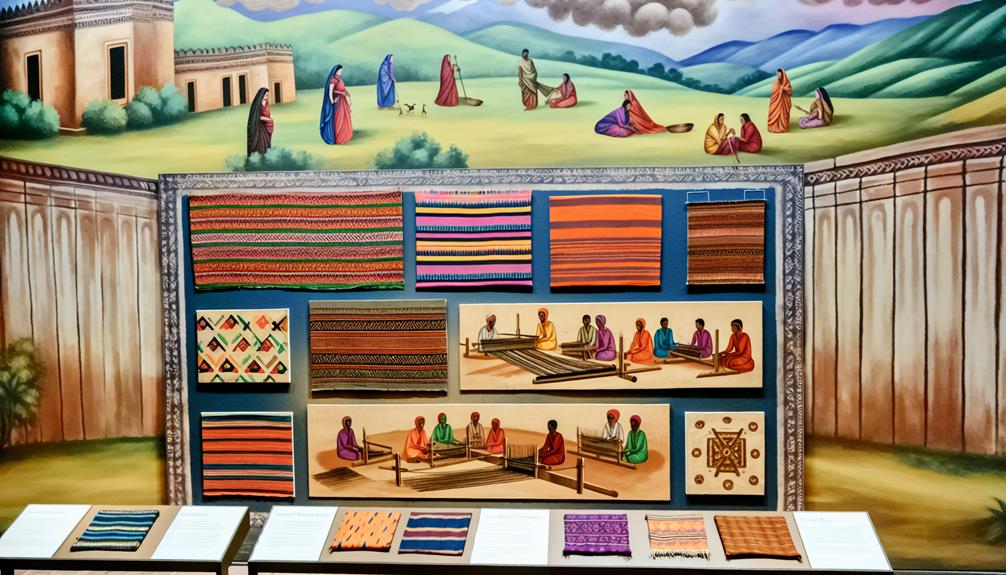
Understanding fabric origins entails exploring the multifaceted processes that turn raw materials into finished textiles. It begins with fiber sourcing from natural or synthetic origins, each influencing production nuances. Key players include manufacturers who craft these fibers into fabrics, designers who envision their applications, and retailers who connect them to consumers. Ethical sourcing practices are critical, as they guarantee fair labor and environmental sustainability. By tracing fabric origins, consumers can foster a meaningful connection with their textiles while promoting responsible consumption. This inquiry invites further exploration into the intricate relationships and histories embedded within your clothing.
Key Takeaways
- Fabric origins start with raw materials processed into fibers, influencing the final textile and its properties.
- Identifying fabric sources includes tracing manufacturing processes and evaluating ethical practices within the supply chain.
- Ethical sourcing supports fair wages and safe working conditions, promoting sustainability in textile production.
- Understanding fabric origins fosters consumer connection to craftsmanship, heritage, and environmental impact of textiles.
- Transparency in textile sourcing encourages responsible consumption and supports brands committed to ethical practices.
The Journey of Fabric

The journey of fabric encompasses a complex interplay of natural and synthetic processes, weaving together the threads of history, technology, and culture. At the heart of this journey lies fabric production, an intricate system that begins with fiber processing. This initial stage involves transforming raw materials into usable fibers, whether derived from plants, animals, or synthetic sources. Each type of fiber presents unique properties that influence the subsequent stages of production. As awareness initiatives for sustainability and ethical production gain traction, consumers are increasingly interested in the origins of their fabrics, leading to a demand for transparency in the textile industry, reflecting broader themes of environmental awareness that resonate with today's socially conscious shoppers.
Fiber processing is not merely a mechanical endeavor; it is a nuanced art that reflects the cultural and environmental contexts of its origin. Techniques vary globally, showcasing local traditions and innovations—factors that contribute to the identity of the fabric itself. For instance, cotton, a staple in many wardrobes, undergoes a distinct processing method that contrasts sharply with the treatment of wool or polyester.
As consumers become increasingly aware of these processes, they seek a deeper connection to the products they choose. Understanding the journey of fabric fosters a sense of belonging, bridging the gap between individual choices and the broader narratives of craftsmanship, sustainability, and ethical production that define our shared human experience.
Types of Fabric Fibers
Understanding the various types of fabric fibers is fundamental to grasping the nuances of textile production and their implications on sustainability and performance. The landscape of fabric fibers can be broadly categorized into natural fibers and synthetic fibers. Natural fibers, such as cotton, wool, and silk, are derived from plants and animals, often contributing to eco-friendly fibers that are biodegradable and renewable. In contrast, synthetic fibers, like polyester and nylon, are man-made and can offer enhanced fiber durability and performance fabrics, although they often lack the sustainability of their natural counterparts.
To achieve lasting success in textile production, it is crucial to celebrate small victories in the development of sustainable practices and innovative materials. Fiber blends are another significant aspect, combining the properties of both natural and synthetic fibers to optimize performance while maintaining comfort. This innovation allows for the creation of textiles that cater to specific needs, such as moisture-wicking or stretchability. In addition, the rise of organic textiles reflects a growing consumer demand for ethically sourced materials. Understanding fiber sourcing, fiber identification, and the latest textile innovations is crucial for consumers looking to make informed choices. As we navigate the complexities of fabric fibers, we cultivate a deeper connection to the materials that shape our daily lives.
The Importance of Ethical Sourcing

Ethical sourcing plays a pivotal role in shaping the textile industry, influencing not only the environmental impact of fabric production but also the social dynamics within supply chains. As consumers increasingly gravitate towards ethical fashion, the demand for transparency in sourcing practices has surged. This shift compels brands to evaluate their supply chains critically, ensuring that materials are sourced from suppliers who uphold fair trade principles. The evolving perceptions of professionalism in various fields, including the legal profession, highlight the importance of authenticity and personal expression, which resonates with the ethos of ethical sourcing.
The importance of ethical sourcing extends beyond mere consumer preference; it fosters a sense of belonging among conscientious buyers who seek to align their values with their purchases. By choosing ethically sourced fabrics, consumers contribute to a system that supports fair wages, safe working conditions, and sustainable practices. This creates a ripple effect, encouraging manufacturers to adopt responsible sourcing strategies that benefit both the environment and the communities involved in production.
Moreover, ethical sourcing serves as a catalyst for innovation in the textile industry. Companies are now exploring alternative materials, such as organic fibers and recycled textiles, which not only reduce environmental impact but also promote social equity. The collective effort towards ethical sourcing signifies a transformative movement towards a more responsible and equitable fashion industry, inviting consumers to be active participants in this change.
Key Players in Fabric Production
Fabric production is influenced by a diverse array of key players, each contributing to the intricate web of the textile supply chain. At the forefront are fabric manufacturers, who transform raw materials into finished textiles. These entities are essential, as they not only dictate the quality and characteristics of the fabric but also play a significant role in driving textile innovations. Understanding the impact of design and production processes can enhance consumer awareness, similar to how understanding coverage options influences health decisions.
In addition to manufacturers, various stakeholders, such as designers, suppliers, and retailers, form a cohesive network that shapes consumer experience. Designers envision the final product, while suppliers provide indispensable resources, including fibers and dyes, ensuring that the creative vision can be realized. Retailers, in turn, serve as the important link between manufacturers and consumers, facilitating the flow of fabrics from production to the market.
Furthermore, advancements in technology have enabled these key players to adopt innovative practices that enhance production efficiency and fabric performance. As consumers become increasingly aware of the complexities behind fabric origins, understanding the roles of these key players fosters a sense of connection and belonging within the textile community. Each player, from manufacturer to retailer, contributes to a rich tapestry of creativity and craftsmanship that defines the world of fabrics.
Sustainable Practices in Textile Industry

Sustainability has emerged as a cornerstone of contemporary textile practices, reflecting a growing awareness of environmental and social impacts within the industry. The adoption of eco-friendly dyes and organic materials signifies a shift toward more responsible manufacturing processes, reducing toxic chemical runoff and promoting healthier ecosystems. In this situation, sustainable farming practices are essential, as they prioritize soil health and biodiversity while minimizing resource depletion. Additionally, adhering to principles like the Expense Recognition Principle can enhance the financial transparency of textile companies by ensuring that costs associated with sustainable practices are accurately reflected in their financial statements.
Fair trade initiatives also enhance the ethical dimension of textile production, ensuring that artisans and workers receive equitable compensation and working conditions. The concept of circular fashion encourages designers to create garments that are not only stylish but also recyclable or biodegradable, thereby fostering a closed-loop system that reduces waste.
Utilizing renewable resources is another vital element, as it lessens dependence on finite materials and promotes long-term sustainability. Green certifications play an essential role in identifying brands committed to these principles, providing consumers with transparency and fostering a sense of belonging to a community that values ethical consumption. Ultimately, embracing responsible consumption can drive meaningful change, aligning consumer choices with the overarching goal of a more sustainable textile industry.
Tracing Fabric Origins
As consumers increasingly demand transparency in the products they purchase, the importance of tracing the origins of textiles has become paramount. Understanding the journey of fabric—from its raw fiber to the finished product—allows consumers to make informed decisions that align with their values. This process involves meticulous fiber identification and an exploration of what can be termed the fabric genealogy.
To elucidate the complexity of tracing fabric origins, consider the following framework:
| Step | Description |
|---|---|
| Source Material | Identifying the natural or synthetic fiber used. |
| Manufacturing | Understanding the processes involved in fabric creation. |
| Supply Chain | Mapping the route from producer to retailer. |
| Ethical Practices | Evaluating the sustainability and labor conditions. |
Each step is integral in thoroughly tracing the fabric's history. By engaging in this investigative journey, consumers can cultivate a deeper connection to their textiles, aligning their choices with ethical and sustainable practices. This quest for knowledge ultimately fosters a sense of belonging within a community that values authenticity and integrity in its fabric choices.
Cultural Significance of Textiles

The cultural significance of textiles extends beyond their functional use, embodying a rich tapestry of historical practices and symbolic meanings. Each fabric and its intricate patterns often reflect the beliefs, values, and narratives of the societies that produced them, revealing insights into social structures and traditions. Analyzing these elements invites a deeper understanding of how textiles serve as both artistic expressions and cultural artifacts, preserving the identity of communities across time.
Historical Textile Practices
Textiles have long served as a powerful medium for cultural expression, reflecting the values, beliefs, and identities of societies throughout history. The historical practices surrounding textiles reveal much about the civilizations that produced them. Ancient techniques, such as weaving, dyeing, and embroidery, were not merely functional; they were imbued with cultural significance, often passed down through generations. Each stitch and pattern carried the weight of tradition, serving as a narrative thread connecting the past to the present.
Moreover, the textile trade played an essential role in the diffusion of cultural practices, facilitating exchanges between distant communities. As textiles traveled across borders, they brought with them stories, styles, and innovations that enriched local customs. This trade transformed textiles into vehicles of identity, allowing communities to assert their uniqueness while simultaneously engaging with global influences.
In examining these historical practices, one can appreciate the intricate tapestry of human experience woven into textiles. Such an understanding fosters a deeper connection to the fabric we encounter today, inviting us to reflect on our own identities and the rich heritage that shapes our contemporary textile landscape.
Symbolism in Patterns
Patterns in textiles often serve as a visual language, rich with symbolism that conveys cultural narratives and societal values. The intricate designs found in various fabrics are not merely aesthetic; they embody profound pattern meanings that reflect the beliefs, traditions, and histories of the communities that create them. Each motif can represent significant cultural elements, such as fertility, protection, or spirituality, thereby inviting deeper connections among those who engage with these textiles.
The design influences shaping these patterns are equally compelling, stemming from the environments, materials, and historical contexts of their makers. For instance, indigenous textiles may feature geometric shapes inspired by local landscapes or flora, while contemporary designs might blend traditional motifs with modern aesthetics, creating a dialogue between the past and the present. Such textiles not only serve practical purposes but also act as vessels of identity, allowing individuals to express belonging to a certain heritage or community.
How to Support Ethical Brands
Supporting ethical brands requires a discerning approach that prioritizes transparency and sustainability in the fashion industry. As conscious consumers, we must scrutinize the practices behind the brands we choose to support. Ethical certifications provide an essential benchmark, helping us identify companies committed to fair trade practices and supply chain accountability.
To navigate your choices, consider the following table, which highlights key aspects of ethical brands:
| Criteria | Importance |
|---|---|
| Ethical Certifications | Guarantees adherence to fair practices |
| Artisan Collaborations | Supports local artisans and economies |
| Eco-Friendly Materials | Reduces environmental impact |
When engaging with brands, seek those that embrace local sourcing and prioritize brand transparency. Transparency not only fosters trust but also cultivates a sense of belonging within a community of like-minded consumers. By choosing brands that align with your values, you contribute to a larger movement of sustainability and responsibility in fashion. In doing so, you empower artisans and promote a culture of conscious consumerism that respects both people and the planet.
Frequently Asked Questions
How Can I Identify the Origin of My Fabric at Home?
Identifying the origin of your fabric at home requires a meticulous examination of fabric labeling and fiber content. Start by checking the care tags, which often indicate the manufacturer's details and country of origin. Additionally, researching the specific fiber content can provide insights into the manufacturing process and potential geographical ties. Engaging with fabric communities or forums may also enhance your understanding, fostering a sense of belonging among those who share similar interests in textiles.
What Certifications Indicate Ethical Fabric Sourcing?
Certifications that indicate ethical sourcing of fabric are essential for discerning consumers. Sustainable certifications, such as Global Organic Textile Standard (GOTS), OEKO-TEX, and Fair Trade, serve as benchmarks for evaluating the integrity of fabric production. These certifications guarantee that materials are sourced responsibly, minimizing environmental impact and promoting fair labor practices. By prioritizing fabrics with these certifications, consumers not only support ethical practices but also foster a deeper connection to the origins of their clothing.
Are There Specific Countries Known for Fabric Production?
Certain countries have gained prominence in fabric production due to their rich textile history and cultural significance. Nations such as India, China, and Italy are renowned for their unique techniques and materials, which reflect distinct cultural identities. The craftsmanship in these regions not only showcases their heritage but also influences global fashion trends. Understanding the origin of fabrics fosters a deeper appreciation for the artistry involved, inviting consumers to connect meaningfully with the textiles they choose.
How Do Fabric Blends Affect Sustainability?
Fabric blends notably impact sustainability through their sourcing and lifecycle management. Sustainable sourcing of fibers, coupled with fiber recycling initiatives, enhances the ecological footprint of blended fabrics. However, the complexity of blends can complicate recycling processes, potentially leading to increased waste. Analyzing the composition and sourcing practices of these blends is essential for fostering a circular economy, ultimately promoting a sense of belonging within environmentally-conscious communities working towards sustainable textile solutions.
What Are the Environmental Impacts of Synthetic Fabrics?
The environmental impacts of synthetic fabrics are multifaceted. Primarily, their production involves significant resource consumption, contributing to energy use and chemical runoff. Moreover, the degradation of synthetic materials releases microplastic pollution into ecosystems, adversely affecting marine life and food chains. Effective waste management practices are vital to mitigate these effects, yet they remain challenging due to the durability of these fabrics. A thorough understanding is essential for sustainable textile practices in the fashion industry.




